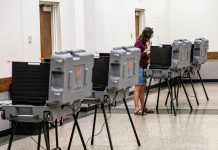Testimony in a court hearing to determine if an expelled Columbus East High School student accused of making a threat against the school should be tried as an adult contained details about the anxiety students and parents experienced in the hours after the Feb. 21 incident.
“There were lots of rumors and questions,” Columbus police officer Julie Quesenbery, assigned as East resource officer, said in Bartholomew Juvenile Court Monday afternoon, testifying for more than an hour.
“The students were very anxious. Some were panicked,” Quesenbery said. “There was a culture of kids feeling fearful.”
In later testimony, school officials said the attendance rate at East, which has about 1,500 students, plummeted from 94 percent the day of the threat to 77 percent the next day, which means about 350 East students did not go to school the day after the Feb. 21 incident — almost 300 more than usual.
The hearing for the 16-year-old former East student was continued until Monday, when testimony will be given by a juvenile probation department representative and the teen’s mother.
The teen is accused of sending a social media threat against the school on SnapChat after students had been evacuated for an accidental fire drill. He is also accused of sending a picture of himself holding a weapon on social media, court records state. The boy is accused of two Level 6 felony charges — the least serious among felonies — of intimidation, and prosecutors have asked that his case be moved to adult court.
The incident happened the day after a different 16-year-old, a current East student, was accused of communicating a threat to shoot up the school in two days, which was reported to authorities immediately Feb. 20, school officials said. The student was located in the school within five minutes and isolated from the student body, and then taken into custody, Quesenbery testified. He is also accused of Level 6 felony intimidation, court records state.
However, the incident involving the teen in the Feb. 21 incident involved a longer search time and contributed to more anxiety among students, parents and staff, who were initially scared by the fire alarm, and then more frightened when word of the social media threat spread from the 300 students who received the message, Quesenbery said.
Similarities to Parkland
The fire alarm was particularly frightening for many students because an alarm had also been tripped in the Parkland, Florida, high school shooting Feb. 14, which resulted in the deaths of 14 students and three staff members at Marjory Stoneman Douglas High School.
Some Columbus East students, teachers and staff refused to exit the school even though the fire alarm had sounded because of their fear of what had happened in the Parkland shooting, Quesenbery said.
After a fire alarm had been set off at the Florida school, students and staff walked into the shooter’s path.
As school began Feb. 21 for Columbus East students, Quesenbery went to a staff meeting with school administrators, counselors and others for a debriefing of the Feb. 20 threat incident. The fire alarm went off at about 7:45 a.m. and the group knew immediately it was not a planned fire drill, she said. The administrator who schedules fire drills, school dean Michael McBride, was in the meeting and confirmed it.
Quesenbery said she went to the school’s second floor, the open resource area, to see if the problem had originated there. In the meantime, McBride learned it went off near the athletics area.
Assistant Principal Charles Edwards went to that area and texted to administrators that he thought he knew what had caused the alarm, students moving equipment accidentally knocked a fire alarm box off the wall.
“It was accidental, but it was really bad timing,” Quesenbery said.
As Columbus East students returned to the building, the school resource officer returned to her office on the first floor, where a student and teacher were waiting.
“She had posted a short video of kids standing outside during the drill, and a comment placed on the SnapChap post frightened her,” Quesenbery said.
The message was a slang comment of “It’s finna get shot up,” which Quesenbery took a screen shot to document, including the screen name of the sender, which was later linked to the expelled student.
Quesenbery said she initially did not know what it meant, but later learned it was a reference to Parkland.
That posting was followed by a picture on Snapchat of the expelled 16-year-old student holding a handgun in the foreground of the photo, which was also photographed by the school resource officer, who also identified the teen from the image, she said.
“The (East) students were very anxious. Some were panicked.”
— Police officer Julie Quesenbery following fire alarm, threat
She called for more police help, including more city police officers and Bartholomew County Sheriff’s deputies, who went to look for the former student at the home addresses the school had on file, but were unable to locate him.
“It did disrupt the school day,” McBride testified. “We were fielding phone calls and students started to leave. Parents were showing up to take kids out. Students were questioning their safety.”
As the investigation continued, Quesenbery testified the expelled teen called one of the female students who received the SnapChat message, and the student handed her phone to the school resource officer, who spoke with him while recording the conversation on a body camera.
The recording was played in court, which purports to be the expelled teen demanding that Quesenbery return the phone to the female student, a racial slur and profanity directed at Quesenbery and a statement that the female student had “snitched” on him.
Quesenbery said the particular words used in the conversation had been directed at her before by the expelled student, prior to the time he had been asked to leave East in October 2016 for bringing marijuana to school and attempting to sell it.
The expelled student and his mother walked into the Columbus Police Department at about 10 a.m. Feb. 21, where he was taken into custody, Quesenbery said.
Previous interactions
In other testimony, several police officers detailed their previous interactions with the expelled teen, including incidents in which he was accused of threatening his mother with a butcher knife as she locked herself in a bathroom in Decatur County, and a domestic incident in which he was accused of threatening to stab and kill his stepfather and then kill himself, which occurred in Bartholomew County.
Officers also talked about an incident in which the teen was suspended after a video was turned in to Quesenbery showing the 16-year-old walking to the back of an East classroom and hitting another male student in the face.
He was also accused of stealing his mother’s debit card, withdrawing cash and using the money to buy marijuana, police officers testified.
Franklin attorney Andrew Eggers objected to having any of these incidents considered as part of the record in determining whether the juvenile should be prosecuted in adult court, saying charges were never filed in any of the incidents.
Mollo ruled that Eggers could object to specific questions or testimony by the officers, but allowed the testimony to continue in that it was a reflection of evaluating the juvenile’s threat to public safety, which is a consideration in whether the juvenile’s case should be moved to adult court.
Eggers asked questions of Quesenbery, requesting that she clarify why the date on the photo of the juvenile holding the gun said “two weeks ago,” inferring that the date on the photo of the teen with the gun was taken two weeks before the date it was transmitted on SnapChat.
He also argued that the teen’s phone could have been used by someone else, and that it was unfair to bring up incidents prior to Feb. 21 where police were called, the juvenile was taken into custody, but no charges were filed against the teen by prosecutors.
At one point, Eggers asked Mollo to order The Republic not to publish a story on the continued hearing, as it was not completed, and also to order the newspaper not to reveal the identity of the teen. Mollo declined to grant either request.
Before the hearing, Mollo explained to the teen, Eggers and the teen’s family that state law allows the newspaper to cover the juvenile court hearings because the charges, while in juvenile court, would be felonies if committed by an adult.
The Republic is also free to release the student’s name, even if the individual is a juvenile. Eggers said he understood if the teen’s case is waived to adult court, the name could be revealed publicly.
After the hearing, the teen’s mother protested to Mollo that her family had received threats on social media as a result of media coverage of the case.




